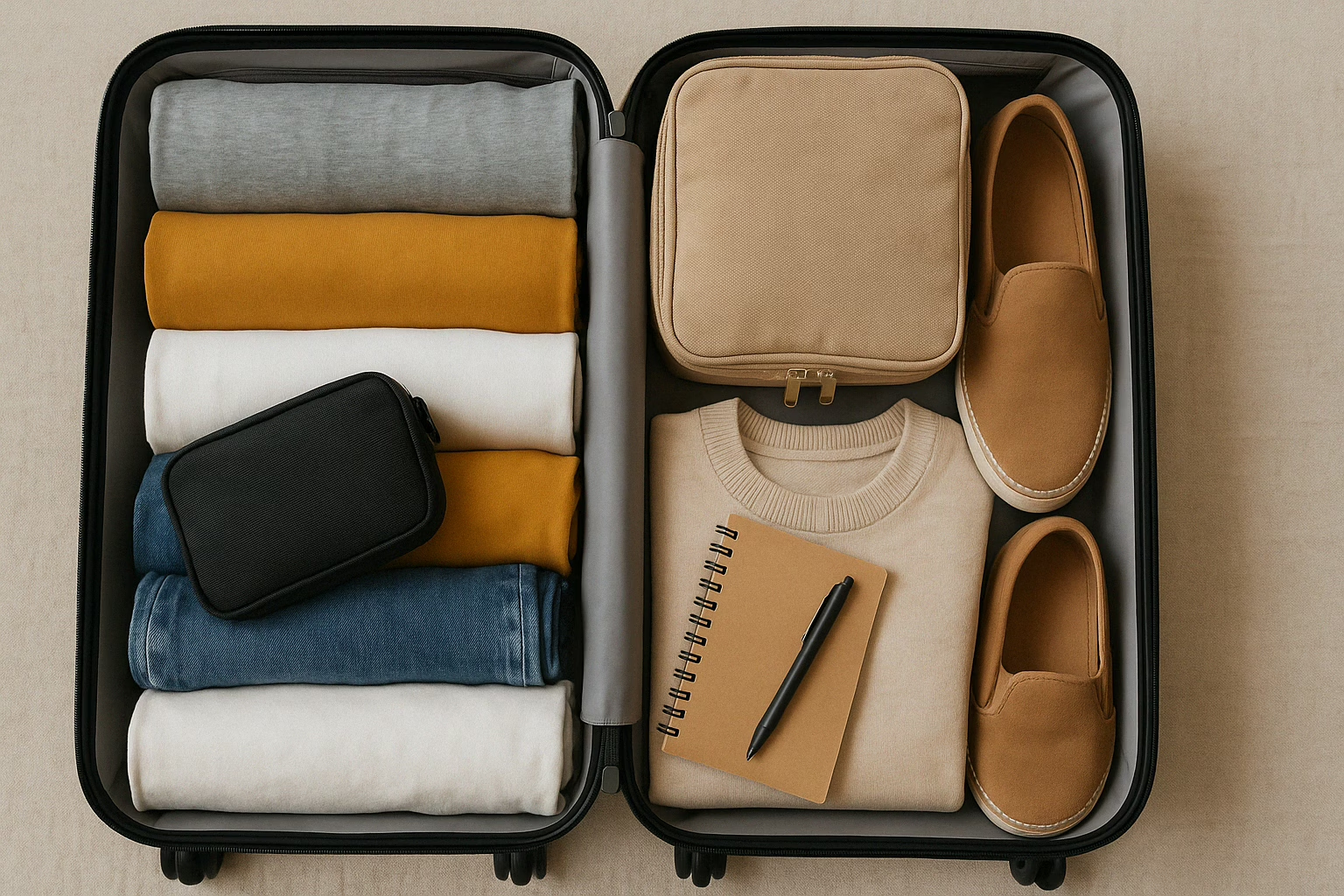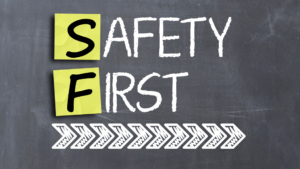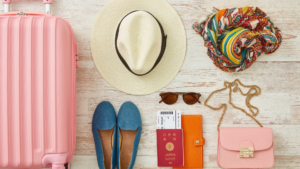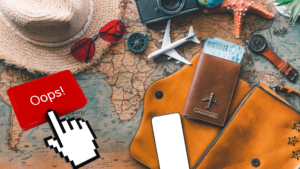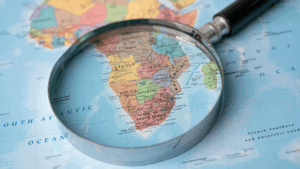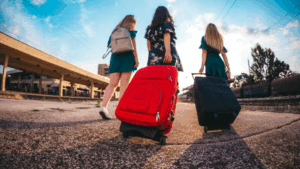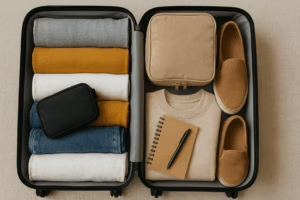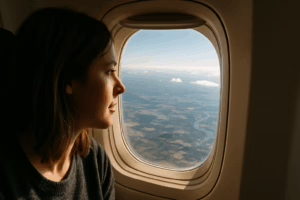Choose the Right Luggage
Let’s start with your foundation: your luggage. For most travelers, a carry-on-sized roller suitcase plus a personal item like a large backpack or tote bag offers the ideal balance of mobility and space. If you do check a bag, choose a medium-sized suitcase, not an oversized one that becomes a burden.
Opt for lightweight, durable materials and compartments that help with organization. Compression packing cubes, for example, save space while keeping items tidy. If your trip includes multiple flights or train rides, look for spinner wheels and a suitcase that can handle uneven terrain. Brands like Away, Samsonite, and Monos offer travel, terrain, and longevity-tested suitcases.
Build a Capsule Wardrobe
A capsule wardrobe includes neutral colors and breathable fabrics that can be layered and mixed. Think 3 to 5 tops, 2 to 3 bottoms, one versatile dress or jumpsuit, and a lightweight jacket. This way, you have options without sacrificing style.
Simple colors such as blacks, grays, whites, navy, or earth tones work well to allow your pieces to complement each together. Add a few accessories to change up your look, like a scarf, belt, or statement earrings. Shoes take up space, so limit yourself to three pairs: one walking shoe, one dressier option, and one sandal or casual shoe. Merino wool and quick-dry fabrics are your friend, especially if you plan to do laundry halfway through the trip.
Think in Layers for Varied Climates
If you’re visiting places with different weather patterns, layering is your best strategy. A packable rain jacket, a warm base layer, and a sweater can adapt to most temperature swings without weighing down your bag.
Layering also gives you more outfit combinations. A long cardigan can double as a blanket on flights. A light scarf adds warmth and polish. Use vacuum-sealed bags or compression sacks to manage bulkier items like sweaters or outerwear.
Toiletries: Go Small and Solid
TSA rules, carry-on limitations, and limited counter space at your Airbnb are all reasons to downsize your toiletries. Solid shampoo bars, face cleansers, and lotion sticks are a great swap for liquids. Use refillable 3-oz containers for essentials like sunscreen, hair products, and facial moisturizer.
Keep it minimal: toothbrush, toothpaste, deodorant, razor, a few makeup items, sunscreen, and medications. Everything should fit into a quart-sized bag if you’re not checking luggage. Don’t forget a mini first aid kit with travel-size pain relievers, motion sickness meds, and bandages.
Electronics and Accessories
You don’t need to bring your entire home office with you. Keep electronics lean: a phone, a universal travel adapter, charging cables, noise-canceling headphones, and maybe a compact tablet or e-reader.
Consider a portable power bank, especially for days of long sightseeing. If you’re working remotely, a lightweight laptop might be necessary, but leave bulky items like external monitors or tripods behind unless you truly need them. Zip ties and cable organizers can help keep cords from tangling.
Plan for Laundry
Unless you’re off-grid, laundry is easier than ever to do on the road. Many hotels, hostels, and vacation rentals offer washing machines or laundry services. You can also pack a sink stopper and quick-dry detergent sheets to hand-wash essentials in the sink.
Bringing fewer clothes becomes less risky when you plan to do laundry once a week. Pack a small mesh laundry bag to keep worn clothes separate and bring at least one extra zip-top bag for wet swimsuits or muddy shoes.
Personal Items and Travel Day Essentials
Your personal item should serve as your travel-day survival kit. Pack your passport, printed or digital copies of tickets, travel insurance, a pen, snacks, a reusable water bottle, and an eye mask for long flights. Add a pair of clean socks and a toothbrush to freshen up during layovers.
Include a folder or pouch for receipts, hotel confirmations, and any COVID-era documents still required in certain regions. If you’re bringing physical books, stick to one—they get heavy fast. Download maps offline and keep a note of emergency contacts just in case.
Travel Documents and Money Management
Before you even start packing clothes, gather all the documentation and financial tools you’ll need on your trip. Make photocopies or take clear photos of your passport, driver’s license, and any necessary visas, then store them in a secure digital folder or email them to yourself. Keep printed and digital copies of your travel insurance, accommodation confirmations, and transportation bookings (especially for countries where digital access is unreliable).
Don’t rely on a single debit or credit card. Bring a backup card, ideally from a different bank, and keep it in a separate place. Notify your bank of your travel plans to avoid fraud alerts freezing your account. For destinations where card payment isn’t always accepted, carry some local currency—enough for taxis, tips, and emergencies.
A hidden travel wallet or money belt can safeguard your cash and cards in crowded places. If you prefer not to carry physical cash, consider using digital wallet apps or travel-friendly financial services like Wise or Revolut to avoid high foreign transaction fees. Make a list of emergency contacts, including the phone number for your country’s embassy or consulate in each country you’re visiting.
Traveling internationally? Don’t forget about roaming plans, SIM cards, or eSIM options to keep your phone connected abroad. A fully charged phone isn’t just for directions or Instagram—it’s your lifeline for emergencies, booking confirmations, and mobile payments.
Packing Smart for Special Activities
Three weeks allow for plenty of downtime, but also opportunities for unique excursions like hiking, fine dining, or cultural experiences. This is where selective packing pays off. If you’re planning activities that require specific gear, like snorkeling, yoga, or attending formal events, plan ahead and only bring what you can’t rent or reasonably buy at your destination.
Instead of packing bulky specialty items, research whether your hotel or activity provider supplies them. Many places offer yoga mats, helmets, or beach towels. If you must pack gear, look for travel-sized or collapsible versions. A packable daypack is great for hikes and excursions, while a pair of foldable water shoes can work for both rocky beaches and hostel showers.
For formal or semi-formal outings, one dress or button-down shirt paired with versatile accessories can elevate your look without taking up too much space. A wrinkle-resistant outfit and a travel-sized steamer or wrinkle-release spray can help keep you polished on the go.
And don’t forget fun extras that make your trip more enjoyable: a waterproof phone pouch for beach days, a compact journal for jotting down memories, or a reusable tote for markets and groceries. Special moments deserve special touches, but they don’t have to weigh down your luggage.
Leaving Room for Souvenirs and Surprises
When packing for a long trip, one of the smartest strategies is leaving 10–15% of your suitcase empty. This buffer space is essential for the inevitable souvenirs, gifts, or impulse buys along the way—whether it’s a handmade scarf from a local artisan, a bottle of regional wine, or a new outfit from a charming boutique.
One trick is to pack a lightweight foldable duffel bag in your luggage. It takes up little room but gives you a backup option if you need extra space coming home. Many airlines allow one personal item and one carry-on, so filling the duffel with soft souvenirs or laundry can free up space in your main bag without checking another suitcase.
Pay attention to customs rules when it comes to bringing back food, alcohol, or cultural artifacts. Some items may be restricted or require declarations. Keep receipts and note where each item was purchased to make the return process smooth.
Also, consider that you may pick up new essentials along the way. You might find the perfect pair of sandals halfway through your trip or need an umbrella during an unexpected rainstorm. Packing light gives you the flexibility to adapt and indulge without feeling weighed down.
The ultimate packing win? Returning home with both memories and meaningful items, without your suitcase bursting at the seams. Leave room not just in your bag, but in your plans, for spontaneity and delight. That’s the true spirit of travel.
Expect the Unexpected
A three-week trip is long enough for something to go off script: delayed flights, lost bags, unexpected weather or spontaneous detours. Pack with flexibility in mind.
Bring one outfit in your carry-on that could work for either a casual dinner or a hike. Keep travel insurance info handy. And always carry a copy of your itinerary and emergency contacts offline. Being prepared doesn’t mean packing more—it means packing smart.
TL;DR: Packing for a 3-Week Trip
- Choose lightweight, functional luggage with compartments and compression cubes
- Build a capsule wardrobe around neutrals and layers
- Limit shoes to three versatile pairs
- Pack toiletries in travel sizes or solid form
- Keep electronics minimal and organized
- Plan to do laundry every 7–10 days
- Use your personal item wisely on travel days
- Pack documents and backup money sources securely
- Prepare for special excursions and unique experiences
- Leave space for souvenirs and spontaneous finds
- Pack smart, not more
